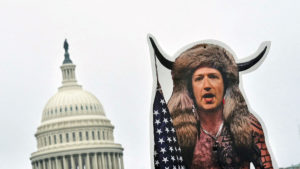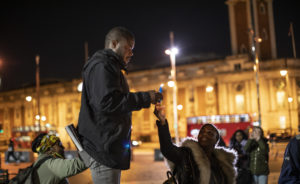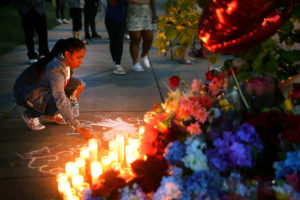Was violent chaos inevitable in America in the summer of 2020? If it was not inevitable, it had at least been predicted. In a 2017 review of Bryan Burrough’s Days of Rage, an account of left-wing terrorism in the Seventies, the historian Peter Turchin suggested that a new era of civil disorder was on the verge of consuming America.
Writing in the early months of the Trump administration, he prophesied that at any moment, a “symbolic event” involving a “sacrificial victim” might ignite the powder keg of political violence and plunge the nation into bloody strife. Turchin cited the 1969 FBI murder of Fred Hampton, which inspired the insurgency narrated in Burrough’s book, and the 2011 self-immolation of the Tunisian fruit vendor Mohammed Bouazizi, credited with setting off the Arab Spring, as examples of such an event.
Just over three years later, the murder of George Floyd and the barely precedented wave of unrest that came in its wake seemed to fit the bill. Suddenly, Turchin’s warning of “the coming violence spike of 2020” looked remarkably prescient. As a result, he enjoyed a period of minor celebrity, and his dark prognoses spawned a small cottage industry of think-pieces. This was understandable: the chaos that erupted in the summer of 2020 left many bewildered, and Turchin’s treatment of it as a new iteration of familiar historical patterns was, in a way, reassuring — despite the fact that he claimed instability and even civil war were on the horizon.
Two years on, Turchin’s prophecies seem less apt. In the end, the nation avoided the escalating spiral of violence he asserted would follow from a “sacrificial” event like Floyd’s murder. Certainly, back in 2020 we saw an astonishing amount of property destruction and a smattering of isolated violent incidents, notably Kyle Rittenhouse’s fatal shooting of three men in Kenosha, Wisconsin.
But soon enough, most of the activist energy as well as the organisational prowess on display that summer was re-enlisted into the effort to elect Joe Biden. Since that was achieved, nothing comparable has occurred. The January 6 Capitol riot, for all its shock value, was a one-off event whose “body count” was made up mostly of rioters who died of natural causes; Rittenhouse’s acquittal late last year, contrary to predictions, led to no major unrest.
Rather than a “chain of revenge and counter-revenge” of the sort Turchin warned about, whatever sporadic instability has followed 2020 looks like an incoherent jumble of disconnected crises and panics, none of which has ever seemed to reach a definitive resolution. Claims of impending civil war continue to resurface now and again, but they seem to serve mostly as periodic ritual invocations useful to a ruling elite that legitimises its rule by invoking states of emergency and must keep an array of spectral threats in reserve for this purpose.
In fact, the story that hovers behind all of the sound and fury of the past two years is the post-Trump reconsolidation of what some call “the regime”: the diffuse power structure consisting of the two major party apparatuses, government bureaucracies, the corporate media, and the nonprofit-industrial complex. Trump’s presidency posed various challenges to these structures, albeit ultimately more on a symbolic than a practical level. Nowhere has this renewed solidity been clearer than in the broad consensus in support of Ukraine. But perhaps surprisingly, the origins of this renewed stability may be traced back to the aftermath of George Floyd’s death.
As Turchin anticipated, in death, Floyd became a galvanising collective symbol, comparable to other quasi-sacrificial victims who have energised mass movements across history. A man who in life had been a precariously employed former aspiring athlete and rapper and who spent a decade drifting in and out of jail became, after the viral broadcasting of his death, a global icon. Transfigurations like this are not unheard of in history, but are more common in the realm of myth and religion than modern politics. It is fitting that so much of the Floyd iconography that suddenly appeared across the world framed him as a martyr, a saint, and even Christ himself.
A good deal of ink has been spilled over the question of whether “wokeness” — closely identified with the cause of racial justice given impetus by Floyd’s death — should be described as a religion rather than a mere political movement. But the question proceeds from an overly neat distinction between these two phenomena. Any political formation that succeeds in assembling an enthusiastic public must partake of “religious” elements. In other words, political groupings must be forged and renewed through experiences of “collective effervescence”, the sociologist Émile Durkheim’s term for the shared experiences of the sacred that bind people together.
This is what George Floyd’s quasi-sacrificial death offered to a large portion of the liberal public as well as to a centre-Left establishment struggling to counter the threat posed to it by Donald Trump. No doubt, the 2020 protests were often destructive and divisive, but contrary to Turchin’s prognosis of social fracturing, their ultimate effect was to channel previously scattered and demobilised popular energies into the anti-Trump coalition. In this light, it’s unsurprising that all the figureheads and institutions of this establishment, from politicians to corporations to NGOs to universities, were so desperate to associate themselves with Floyd’s image and memory.
Hence, the ironic result of the largest protests in US history was the political triumph of two politicians who had once implemented the same tough-on-crime policies the 2020 protesters decried. Two years after Floyd died, the upward transfer of wealth accelerated by the pandemic shutdowns that deprived him of his livelihood continues apace. Inflation is driving up the cost of living for ordinary people, black neighbourhoods are bearing the brunt of an upsurge in crime, and record numbers of Americans are overdosing on meth and fentanyl — both drugs in George Floyd’s system at the time he died. In a cruel paradox, his death, in meme-ified form, furnished a new ideological legitimation for the same ruling elite that created the conditions for it.
The recent exposure of how Black Lives Matters’ leaders enriched themselves with George Floyd-inspired donations suggests the movement’s lustre is wearing off. But in the meantime, the Russian invasion of Ukraine has offered our ruling cadre yet another noble cause for rallying the public — once again, making good use of a crisis partly of its own making.
In the long run, perhaps Turchin’s and others’ doomsaying will be borne out. But the restabilising function ultimately served by George Floyd’s murder reveals the resilience of an establishment capable of repurposing the fallout of its disastrous policies into ad hoc new means of justifying its rule.
Disclaimer
Some of the posts we share are controversial and we do not necessarily agree with them in the whole extend. Sometimes we agree with the content or part of it but we do not agree with the narration or language. Nevertheless we find them somehow interesting, valuable and/or informative or we share them, because we strongly believe in freedom of speech, free press and journalism. We strongly encourage you to have a critical approach to all the content, do your own research and analysis to build your own opinion.
We would be glad to have your feedback.
Source: UnHerd Read the original article here: https://unherd.com





